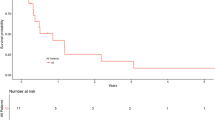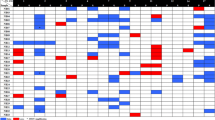Abstract
Meningioma is one of the most common brain tumors, and a variety of genetic abnormalities have been detected by the Southern blotting, polymerase chain reaction (PCR), fluorescence in situ hybridization (FISH), and comparative genomic hybridization (CGH) methods. However, these methods detect only a very limited portion of the tumor genome or have a limited mapping resolution. In this study, we used DNA microarray assay, which detects numerous genetic abnormalities and analyzes a global assessment of molecular events in tumor cells. We analyzed genomic DNA from 26 patients with benign meningiomas by GenoSensor Array 300 in order to characterize gene amplifications, gene deletions, and chromosomal information in the whole genome. Loss of chromosome 22q was found most frequently. This chromosomal aberration was detected in 14 meningiomas (53.8%), particularly in transitional and fibrous meningiomas. In meningothelial meningiomas, amplification ofINS andTCL1A was detected more frequently than in other meningioma subtypes. DNA microarray assay revealed new genetic differences among the meningioma subtypes, thus indicating that this novel technique is useful for understanding tumor genesis and for the diagnosis of meningioma subtype.
Similar content being viewed by others
References
Kleihues P, Sobin LH (2000) World Health Organization classification of tumors. Cancer 88:2887
Kleihues P, Burger PC, Scheithauer BW (1993) The new WHO classification of brain tumours. Brain Pathol 3:255–268
Seizinger BR, de la Monte S, Atkins E, et al (1987) Molecular genetic approach to human meningioma: loss of genes on chromosome 22. Proc Natl Acad Sci U S A 84:5419–5423
Dumanski JP, Carlbom E, Collins VP et al (1987) Deletion mapping of a locus on human chromosome 22 involved in the oncogenesis of meningioma. Proc Natl Acad Sci U S A 84:9275–9279
Ruttledge MH, Xie YG, Han FY, et al (1994) Deletions on chromosome 22 in sporadic meningioma. Genes Chromosomes Cancer 10:122–130
Wellenreuther R, Kraus JA, Lenartz D, et al (1995) Analysis of the neurofibromatosis 2 gene reveals molecular variants of meningioma. Am J Pathol 146:827–832
Daigo Y, Chin SF, Gorringe KL, et al (2001) Degenerate oligo-nucleotide primed-polymerase chain reaction-based array comparative genomic hybridization for extensive amplicon profiling of breast cancers: a new approach for the molecular analysis of paraffin-embedded cancer tissue. Am J Pathol 158:1623–1631
Zhao J, Roth J, Bode-Lesniewska B, et al (2002) Combined comparative genomic hybridization and genomic microarray for detection of gene amplifications in pulmonary artery intimal sarcomas and adrenocortical tumors. Genes Chromosomes Cancer 34:48–57
Hori Y, Hori H, Yamada Y, et al (1998) The methylthioadenosine phosphorylase gene is frequently co-deleted with the p16INK4a gene in acute type adult T-cell leukemia. Int J Cancer 75:51–56
Maruno M, Ninomiya H, Ghulam Muhammad AK, et al (2000) Whole-genome analysis of human astrocytic tumors by comparative genomic hybridization. Brain Tumor Pathol 17:21–27
Maruno M, Yoshimine T, Muhammad AK, et al (1999) Chromosomal aberrations detected by comparative genomic hybridization (CGH) in human astrocytic tumors. Cancer Lett 135:61–66
Batova A, Diccianni MB, Nobori T, et al (1996) Frequent deletion in the methylthioadenosine phosphorylase gene in T-cell acute lymphoblastic leukemia: strategies for enzyme-targeted therapy. Blood 88:3083–3090
Hui AB, Lo KW, Yin XL, et al (2001) Detection of multiple gene amplifications in glioblastoma multiforme using array-based comparative genomic hybridization. Lab Invest 81:717–723
Suzuki T, Maruno M, Wada K, et al (2004) Genetic analysis of human glioblastomas using a genomic microarray system. Brain Tumor Pathol 21:27–34
Kepes JJ (1986) Presidential address: the histopathology of meningiomas. A reflection of origins and expected behavior? J Neuropathol Exp Neurol 45:95–107
Lekanne Deprez RH, Groen NA, van Biezen NA, et al (1991) A t(4;22) in a meningioma points to the localization of a putative tumor-suppressor gene. Am J Hum Genet 48:783–790
Peyrard M, Fransson I, Xie YG, et al (1994) Characterization of a new member of the human beta-adaptin gene family from chromosome 22q12, a candidate meningioma gene. Hum Mol Genet 3:1393–1399
Lindblom A, Ruttledge M, Collins VP, et al (1994) Chromosomal deletions in anaplastic meningiomas suggest multiple regions outside chromosome 22 as important in tumor progression. Int J Cancer 56:354–357
Zankl H, Zang KD (1972) Cytological and cytogenetical studies on brain tumors. 4. Identification of the missing G chromosome in human meningiomas as no. 22 by fluorescence technique. Humangenetik 14:167–169
Szijan I, Rochefort D, Bruder C, et al (2003) NF2 tumor suppressor gene: a comprehensive and efficient detection of somatic mutations by denaturing HPLC and microarray-CGH. Neuromolecular Med 3:41–52
Gutmann DH, Giordano MJ, Fishback AS, et al (1997) Loss of merlin expression in sporadic meningiomas, ependymomas and schwannomas. Neurology 49:267–270
Lekanne Deprez RH, Riegman PH, van Drunen E, et al (1995) Cytogenetic, molecular genetic and pathological analyses in 126 meningiomas. J Neuropathol Exp Neurol 54:224–235
Louis DN, Ramesh V, Gusella JF (1995) Neuropathology and molecular genetics of neurofibromatosis 2 and related tumors. Brain Pathol 5:163–172
Ruttledge MH, Andermann AA, Phelan CM, et al (1996) Type of mutation in the neurofibromatosis type 2 gene (NF2) frequently determines severity of disease. Am J Hum Genet 59:331–342
Kino T, Takeshima H, Nakao M, et al (2001) Identification of the cis-acting region in the NF2 gene promoter as a potential target for mutation and methylation-dependent silencing in schwannoma. Genes Cells 6:441–454
Saint-Jore B, Puech A, Heyer J, et al (1998) Goosecoid-like (Gscl), a candidate gene for velocardiofacial syndrome, is not essential for normal mouse development. Hum Mol Genet 7:1841–1849
Wakamiya M, Lindsay EA, Rivera-Perez JA, et al (1998) Functional analysis of Gscl in the pathogenesis of the DiGeorge and velocardiofacial syndromes. Hum Mol Genet 7:1835–1840
Roberts C, Daw SC, Halford S, et al (1997) Cloning and developmental expression analysis of chick Hira (Chira), a candidate gene for DiGeorge syndrome. Hum Mol Genet 6:237–245
Blumberg B, Wright CV, De Robertis EM, et al (1991) Organizer-specific homeobox genes inXenopus laevis embryos. Science 253:194–196
Halford S, Wilson DI, Daw SC, et al (1993) Isolation of a gene expressed during early embryogenesis from the region of 22q11 commonly deleted in DiGeorge syndrome. Hum Mol Genet 2:1577–1582
Fishel R, Lescoe MK, Rao MR, et al (1994) The human mutator gene homolog MSH2 and its association with hereditary nonpolyposis colon cancer. Cell 77:167
Reitmair AH, Schmits R, Ewel A, et al (1995) MSH2 deficient mice are viable and susceptible to lymphoid tumours. Nat Genet 11:64–70
Friedman HS, McLendon RE, Kerby T, et al (1998) DNA mismatch repair and O6-alkylguanine-DNA alkyltransferase analysis and response to Temodal in newly diagnosed malignant glioma. J Clin Oncol 16:3851–3857
Ho GY, Melman A, Liu SM et al (2003) Polymorphism of the insulin gene is associated with increased prostate cancer risk. Br J Cancer 88:263–269
Gold MR (2003) Akt is TCL-ish: implications for B-cell lymphoma. Trends Immunol 24:104–108
Author information
Authors and Affiliations
Corresponding author
Rights and permissions
About this article
Cite this article
Wada, K., Maruno, M., Suzuki, T. et al. Chromosomal and genetic aberrations differ with meningioma subtype. Brain Tumor Pathol 21, 127–133 (2004). https://doi.org/10.1007/BF02482188
Received:
Accepted:
Issue Date:
DOI: https://doi.org/10.1007/BF02482188




